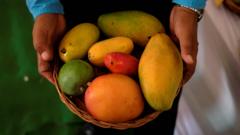India claims its biofuel initiative has significantly reduced carbon emissions and saved foreign exchange, but the shift towards higher ethanol blending raises concerns about vehicle performance and the food supply chain.
India's Biofuel Initiative: Balancing Emissions Savings and Food Security Concerns

India's Biofuel Initiative: Balancing Emissions Savings and Food Security Concerns
As India pushes to increase biofuel blending in petrol, it faces challenges related to vehicle compliance and food production.
India's ambitious drive to blend biofuels, particularly ethanol with petrol, seeks to reduce carbon emissions and retain dollar reserves, yet it has prompted notable apprehensions among vehicle users and agricultural experts. The government recently achieved its goal of a 20% ethanol blend, termed E20, five years ahead of schedule. This initiative has reportedly cut 69.8 million tonnes of carbon dioxide emissions and saved 1.36 trillion rupees (approximately $1.5 billion) in foreign exchange since it began in 2014.
Fuel demand is projected to rise, necessitating a transition to ethanol-blended fuel to mitigate emissions, according to Sandeep Theng of the Indian Federation of Green Energy. Conversely, widespread skepticism among vehicle owners remains. Automotive expert Hormazd Sorabjee warned that with ethanol possessing lower energy density, there is potential for reduced mileage and greater wear on vehicles not designed for E20 compatibility. He noted that while some manufacturers have adhered to E20 material standards since 2009, a significant number of older vehicles may face performance issues.
Compounding these issues, consumers have been discussing negative experiences on social media channels. Many insurance policies in India do not cover damages resulting from the use of non-compliant fuels, leaving vehicle owners seeking additional coverage, which can often be denied due to policy nuances. Despite assurances from the federal petroleum ministry, which describes consumer concerns as largely exaggerated, owners of vehicles incompatible with E20 worry about potential costly modifications.
There are also apprehensions among climate scientists and food policy analysts regarding the agricultural implications of this biofuel initiative. With ethanol produced primarily from crops like sugarcane and maize, expanding ethanol production could divert crops from food supply. Predictions suggest that by 2025, India will need 10 billion liters of ethanol, with demand soaring to 20 billion liters by 2050, leading to possible reliance on food crops.
Recent policies allocating rice stock for ethanol production have raised alarms, particularly in a nation where food insecurity affects approximately 250 million people. Analysts warn that converting food to fuel poses a risk of agricultural disaster. India faces a crucial decision between relying on sugarcane—which provides a higher yield for ethanol but is water-intensive—and food crops like maize and rice.
Experts advocate for maintaining a moderate blending strategy, such as the E10 mix, instead of further increasing to E25 or beyond, which the government has signaled as a future goal. Balancing environmental goals with the nation's agricultural and food security remains a paramount challenge for India as it navigates this transition.






















